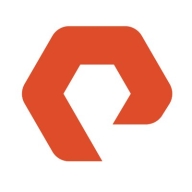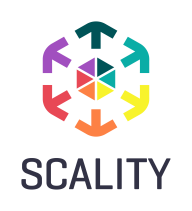


Scality RING and NetApp StorageGRID are competing products in the object storage landscape. Scality RING seems to have the upper hand in pricing with appealing cost benefits, whereas NetApp StorageGRID stands out for its comprehensive feature set.
Features: Scality RING offers scalability, multi-cloud support, and advanced security options, ideal for enterprises focusing on data durability. NetApp StorageGRID provides comprehensive data management, automated lifecycle policies, and efficient storage tiering, focusing on data compliance and governance.
Room for Improvement: Scality RING could enhance its user interface to improve usability. Adding more integration options for diverse enterprise applications would be beneficial. Customer support availability could also be expanded. NetApp StorageGRID would benefit from reduced complexity in its data management features. Simplifying deployment processes could enhance user experience. Expanding cost-saving measures in pricing models would be advantageous.
Ease of Deployment and Customer Service: Scality RING supports on-premises and hybrid-cloud infrastructures, offering flexibility and intuitive scalability. NetApp StorageGRID streamlines deployment through robust data lifecycle management and automation but could enhance its service experience with additional resources and support options.
Pricing and ROI: Scality RING is cost-effective with straightforward pricing, achieving ROI quickly through its simplified scalability. NetApp StorageGRID, despite higher initial costs, offers powerful data management and compliance features, leading to long-term operational efficiencies.
It does not require much management once you set up correctly, so it saves time, allowing an admin to focus on other work.
I think RING's ability to maintain predictable costs while providing scalable storage solutions impacts our budget by allowing us to pay only for capacity.
For instance, while the cost per gig on a block storage platform may be $2, it's $1.50 for NAS, and only $0.50 for object storage, leading to a remarkable 75% reduction in costs by utilizing the Scality platform.
Scality RING has reduced our operating costs.
I would rate them an eight out of ten.
The support is done through email and is not that great, making it a very problematic area I've been dealing with for over four years.
When evaluating the technical support of NetApp StorageGRID, I would give it an eight out of ten.
I would rate the support for NetApp StorageGRID as eight out of 10.
That's due to the fact that we haven't implemented all the technical support facilities in NetApp.
I've always received responses within the required timeframe, the answers were technically relevant, and there was follow-up—people called us back to check if everything was okay and if the ticket could be closed.
Individuals such as Peter Mikolastik really make a difference by saying, 'Come on, what is the problem? I will help you,' rather than just brushing things off.
Technically, when we have major issues in P1, they are very responsive and we can't say that we don't get a response.
Pure Storage FlashBlade is scalable.
The scalability of NetApp StorageGRID has been proven as we've expanded twice.
The scalability of NetApp StorageGRID rates an eight or nine out of ten.
Upwards, I think, almost unlimited by what we can imagine.
I've never had issues with scalability.
We are relatively well informed about their new features, what will be implemented in future versions, and the scalability of the solution.
In case there is any issue with any blade, the data is moved to another.
My impression of the stability of NetApp StorageGRID is quite high; from one to ten, I would rate it a nine.
We experienced very little stability issues.
It is a platform that is very stable at the customer level and does not generate incidents or blockages that you might encounter with standard storage solutions, where you can lose data.
I find that Scality RING is very stable because it allows for many maintenance operations without service loss.
There are factors that can cause Scality RING to become occasionally unavailable, but due to the system's resilience, it is capable of recovering or degrading gracefully.
Technical support definitely needs significant improvement.
Its configuration should be easier.
They need to focus on a better upgrade path with easier and more resilient upgrades.
It would be great if it could fix internal issues itself without manual intervention.
In terms of functionality, reliability, and scalability, we are satisfied with NetApp.
Encryption and data security need improvement. We don't have a solution for customers who need confidentiality.
They should prioritize quality over timeliness to minimize customer disruptions and not force customers into a cycle of fixes that interfere with daily work.
What we are currently missing and will be demanding in the new tender is an additional external backup of all data, ideally on a simple system, to safeguard against any severe local incidents so that we still have the data protected elsewhere.
The pricing of Pure Storage FlashBlade is expensive compared to other products I used from other companies in the past, but one benefit is that they have built-in ransomware protection.
I'd rate the pricing eight out of ten.
It would definitely be more on the expensive side, especially if you compare it with open source solutions like Ceph.
From what I understood, it was cheaper than EMC ECS, though this was over seven years ago.
Fortunately, in terms of the license, we are able to expand the disks without having to adjust the license.
In the end, it always depends on how much you pay for it.
Regarding setup costs and licensing, our initial experience is somewhat dated now as we made a comprehensive purchase, including hardware, software, and system setup, which Scality handled at the time.
We can plug in many blades, and we can have data up to one terabyte.
The best features of Pure Storage FlashBlade include better throughput and better performance.
The feature of NetApp StorageGRID that has significantly improved data storage management for my customers is the value of the S3 API because it allows developers who are not infrastructure-oriented to use it and write code against it.
NetApp StorageGRID is a great alternative to AWS S3 buckets.
The scalability is very effective for our customers.
When a server is lost, the data is still accessible.
It is even better stored when there is only one copy on a system and there is a second copy on an immutability system, which is almost equivalent to backing it up on tape and taking it offline, making it completely inaccessible.
Scality RING has influenced our approach to scaling in different dimensions by providing a cost-effective solution for the tremendous amount of data we generate every day for each customer.
| Product | Market Share (%) |
|---|---|
| Scality RING | 4.2% |
| Pure Storage FlashBlade | 5.7% |
| NetApp StorageGRID | 5.8% |
| Other | 84.3% |



| Company Size | Count |
|---|---|
| Small Business | 11 |
| Midsize Enterprise | 11 |
| Large Enterprise | 20 |
| Company Size | Count |
|---|---|
| Small Business | 5 |
| Midsize Enterprise | 4 |
| Large Enterprise | 11 |
| Company Size | Count |
|---|---|
| Small Business | 3 |
| Midsize Enterprise | 1 |
| Large Enterprise | 12 |
FlashBlade is the industry’s most advanced scale-out storage for unstructured data, powered by a modern, massively parallel architecture to consolidate complex data silos (like backup appliances and data lakes) and accelerate tomorrow’s discoveries and insights.
Store and manage unstructured data at scale using NetApp StorageGRID for secure, durable object storage. Place content in the right location, at the right time, and on the right storage tier, optimizing workflows and reducing overall costs for globally distributed rich media.
Scality RING is the scalable and resilient object storage solution designed for modern workloads, providing seamless data protection against evolving cyber threats.
Scality RING leverages S3 object storage to meet unpredictable demands with a patented MultiScale Architecture that offers limitless scalability across capacity, performance, and more. It delivers end-to-end cyber resilience with CORE5 for ransomware protection, while its cloud-style economics and intuitive management empower enterprises to accelerate AI initiatives and optimize cloud deployments. Its flexibility is ideal for service providers managing extensive data needs.
What are the key features of Scality RING?Scality RING is extensively implemented in backup solutions across industries, supporting platforms like Veeam and CommVault. It aids in storage expansion and management of large data volumes alongside multi-site architectures. While not leading in AI spaces due to performance constraints, there's potential with faster disk support. It's also used in archives, binary lakes, multimedia services, and AI data lakes.
We monitor all File and Object Storage reviews to prevent fraudulent reviews and keep review quality high. We do not post reviews by company employees or direct competitors. We validate each review for authenticity via cross-reference with LinkedIn, and personal follow-up with the reviewer when necessary.